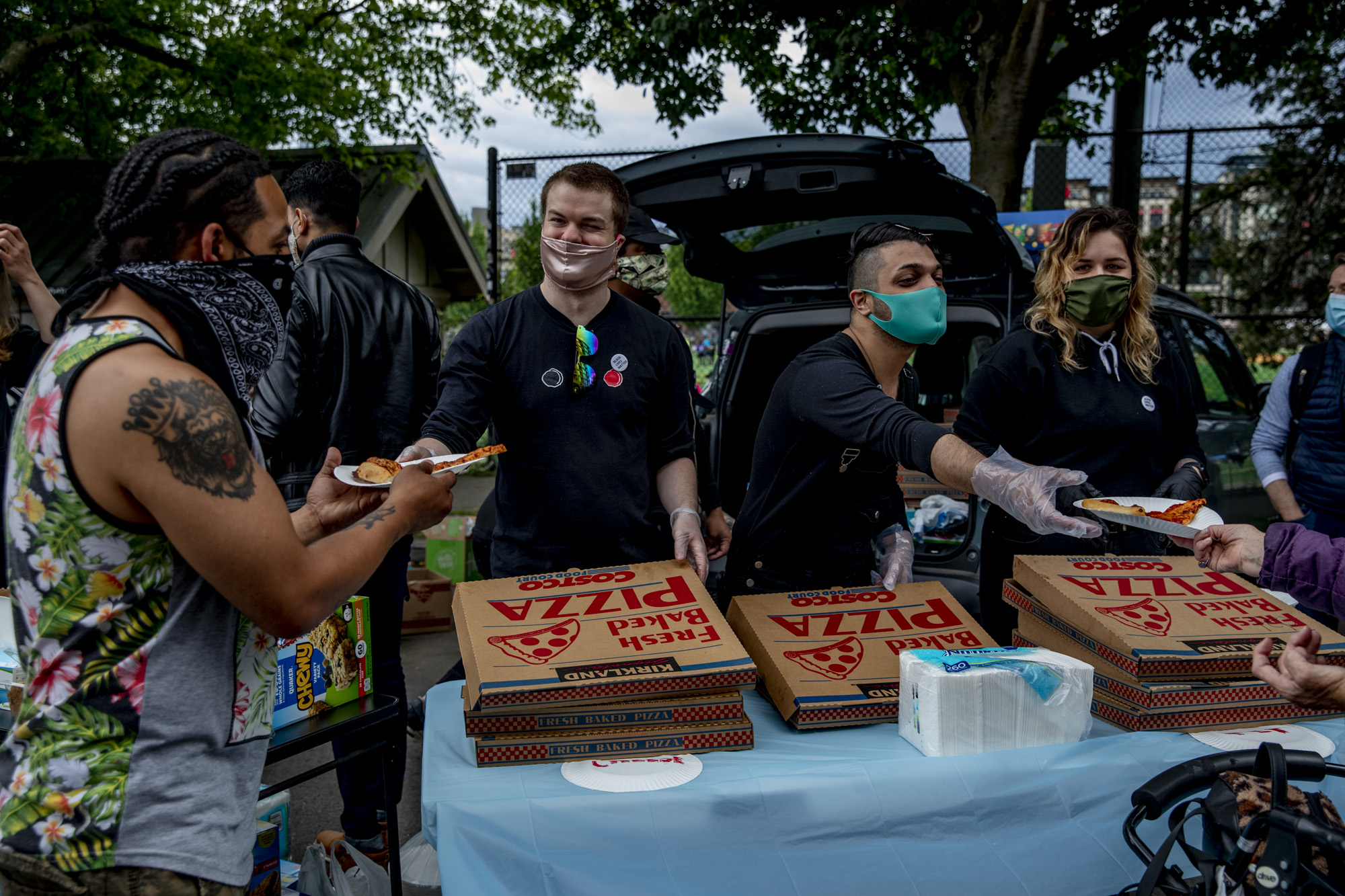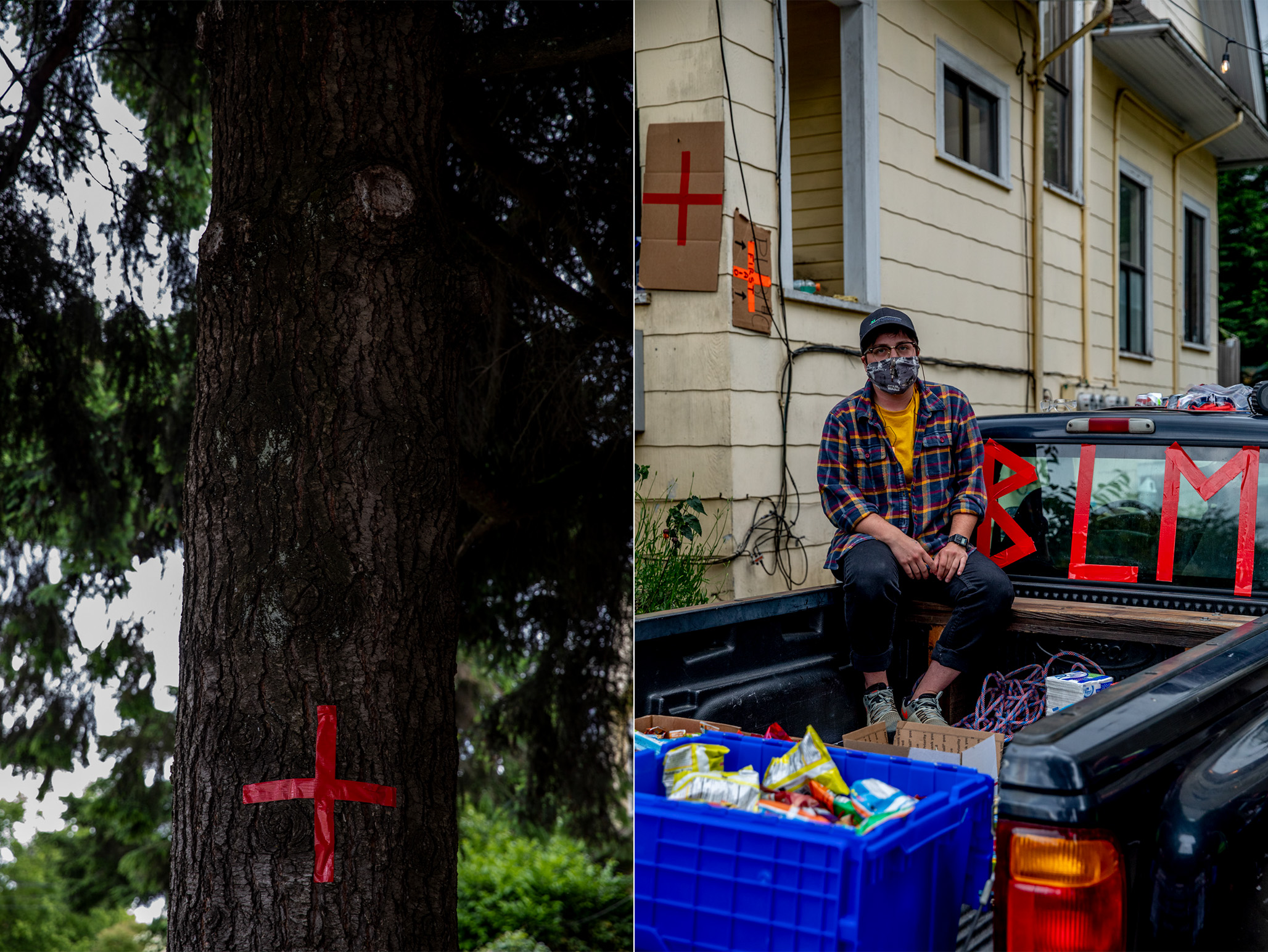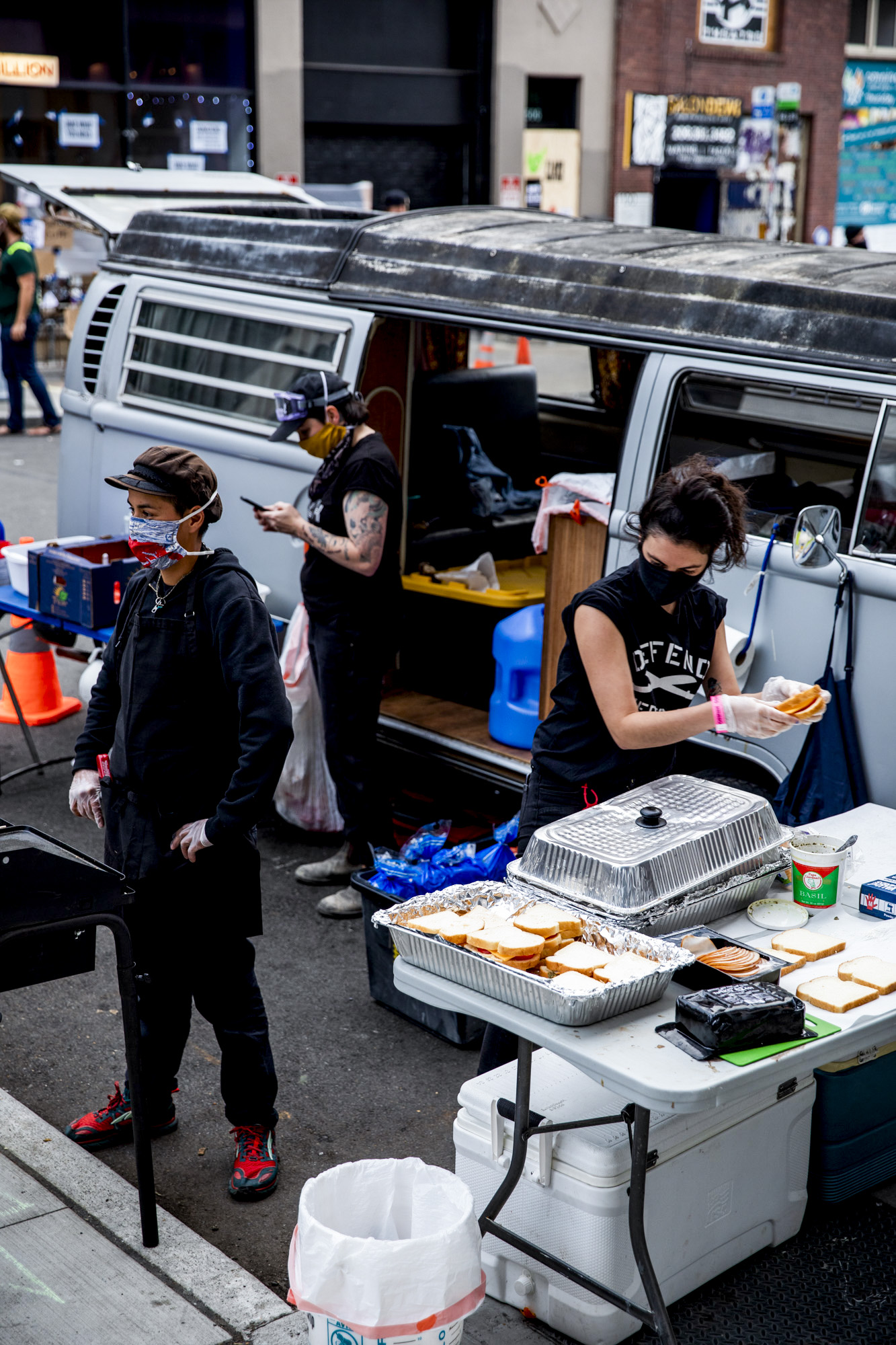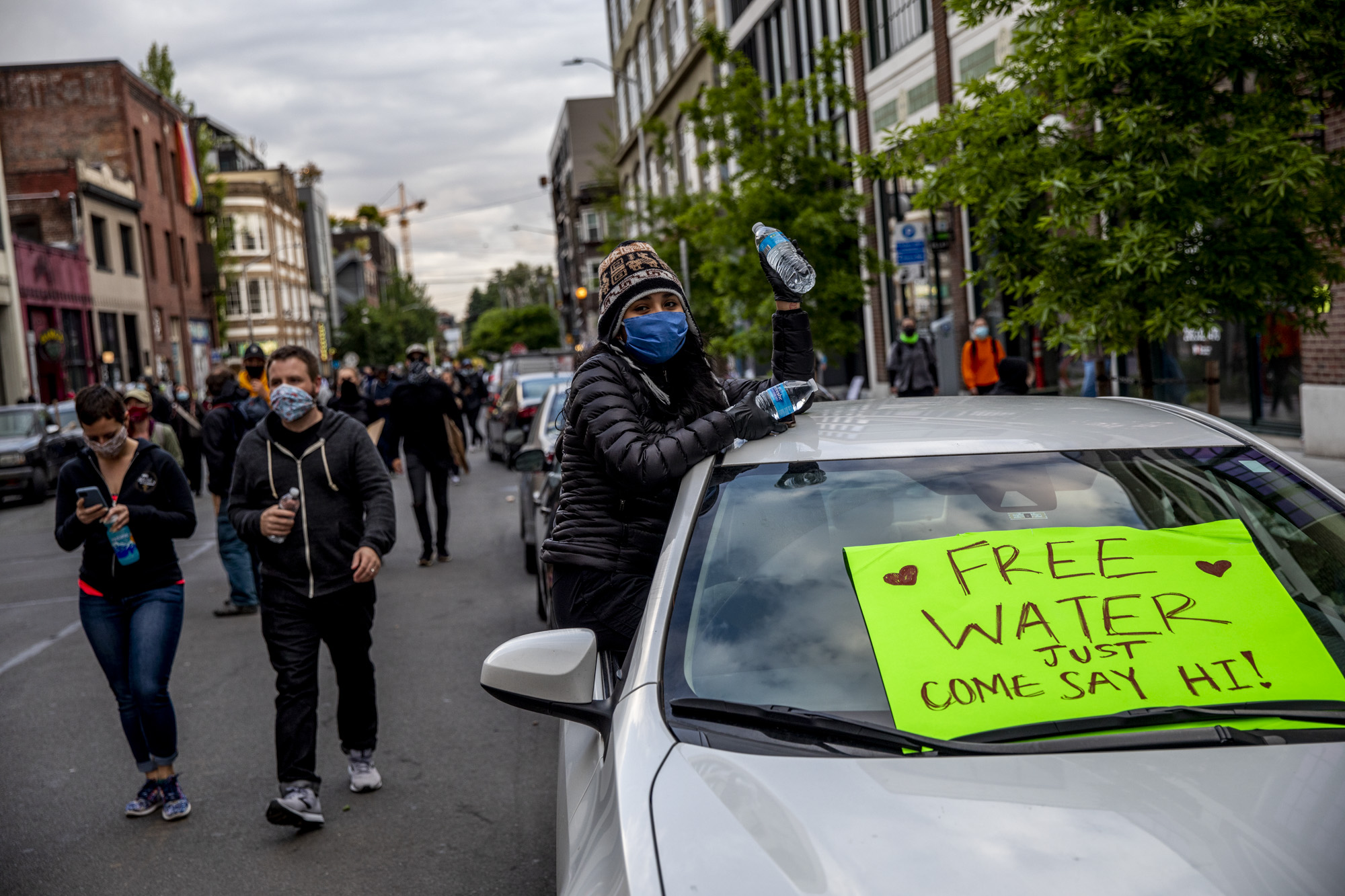This could be a hospital scene, except the red crosses on his sleeve and chest are fashioned from duct tape and he’s on a street on Capitol Hill in Seattle. It's Wednesday, and since the protests began five days earlier, the police barricades near the rainbow crosswalks of 11th Avenue and Pine Street have become a central gathering place for some of the thousands of people marching and protesting against racism and police brutality in all corners of the city. Just 300 feet away, protesters chant “Black lives matter” and “Defund the police” as they face rows of police officers and the National Guard.
A demonstrator walks up to a patch of sidewalk functioning as a makeshift doctor’s office. After a brief exchange, the nursing assistant, who gives his name as Sammy Manila (a nickname for fear of professional reprisal), asks, “You’re diabetic?” He wants to make sure that the person feels all right, has enough snacks and knows to call 911 if they feel unwell. In the meantime, he counsels, “Anyone with a red cross is committed to helping you. We are committed to getting you the care that you need.”
From street protests to City Hall: defunding Seattle Police is now on the table
Manila is one of many health care professionals who have recently joined the volunteer group of street medics set up near the barricades on Capitol Hill. Medic, food and other aid stands have become semipermanent fixtures of Cal Anderson Park and adjacent streets. The makeshift village of aid stations has expanded each day. Digital maps and Google Docs point protesters to local businesses and private homes where they can rest, charge phones and use the bathroom, donate to bail funds and even get registered to vote or find legal representation.
“We have a specialized skill set that we can provide to the public. We cannot trust the police to act in a way that has our best interests at heart,” Manila explains. Nearby, fellow street medics wearing construction or bike helmets emblazoned with red tape run back and forth with boxes of paper towels and other supplies. “As a health care professional,” he says, “I took an oath to have people’s best interest at heart at a physiological and mental level.”
A few such medical volunteers were prominently visible Sunday night, when a man with a gun drove into the crowd of protesters and shot another man in the arm. Street medics and others rushed to help the injured man and walked him to an ambulance. In recent days, volunteer protests medics have also taken care of flash bang, pepper spray and other injuries.
The ethics of a street medic are simple, Manila says: “Everyone is deserving of care.”

First aid isn’t the only grassroots service popping up amid the protests. There’s a growing network of what many are calling “mutual aid,” a system of providing supplies, sustenance and organizing powers long practiced among marginalized communities and in social movements.
Protesters say they’re fighting a worse pandemic than coronavirus: systemic racism
At marches, rallies and protests, it is now common to see people with large backpacks handing out water, snacks and masks. This past weekend, at the “We Want to Live: March for Black Lives and to End Violence," where thousands of participants walked from Othello Park to Rainier Beach, volunteers handed out Ziploc bags full of oranges, cookies, chips, masks, earplugs, Band-Aids and fruit snacks. As the sun broke through the clouds, marchers were sustained by giveaways from food tents (including Pagliacci pizza and Ezell’s chicken) and water bottles from trunks of cars stationed near the route.
On Capitol Hill, cardboard signs affixed to the walls above aid stands direct protesters to personal Venmo accounts for monetary donations, QR codes to sign petitions demanding justice for Breonna Taylor (who was killed by Louisville police in March) and a state-wide petition to hold police officers accountable for police brutality. Some signs bear phone numbers of volunteers offering free rides home. Above a stack of free water bottles on a sidewalk, a sign says, “Free anti-racist fuel.”
As protests continue, labor council tells Seattle police union to address racism or get out
One stand is run by a group of volunteers calling themselves “Pink Umbrella Aid” (referring to the pink umbrella snatched from a protester's hands before police unloaded pepper spray, flash bangs and tear gas on the crowd a week ago). They’ve repurposed the outdoor bar of a nearby restaurant as a display case. It’s like an outdoor shop except everything is free: rows of boxes of fruit snacks, salted peanuts, Gatorade, bread, saline solution and safety goggles for tear gas protection, masks to reduce the spread of the coronavirus, earplugs, gauze, body wipes, nitrile gloves, umbrellas, tampons and even sunscreen (SPF 50).

But it’s not just about giving out free food or supplies, says ethnobotanist and protest volunteer Elayne Eden, who does not give her last name. It’s also a model of how people can care for each other without police intervention. “We desire not a Band-Aid [but] a full, complete change of the system. To change the system, we have to develop our own,” she says.
Just a few nights ago, she says, she heard via walkie-talkie that a person in the crowd was exhibiting signs of a panic attack: heavy breathing, tightness of chest, hyperventilation, screaming and waving of arms. Eden called over a professional therapist who had joined the team. “She talked the person down. It took an hour,” she says. “We took the time,” she says, noting that a police officer might have taken a violent route. (Statistics show that people with untreated mental illness are 16 times more likely to be killed during a police encounter than other civilians approached or stopped by law enforcement, and that Black Americans are nearly three times more likely to die from police than white Americans.) “But instead we were able to hear her and eventually we got to the root of why she was having a panic attack.”
Also tending to the wellness of protesters on this Friday night is Wesley Peacock, a trained massage therapist offering free massages near his parked car. “If we take care of our bodies, we’re able to take care of other people,” explains Peacock, his voice hoarse from marching and chanting for days. “We’re out here for a reason; it’s not a picnic,” he said. “The guy I just massaged said: ‘I feel energized to go out and fight more and longer.’”
Down the street, Audrey De La Rosa is hoping to fuel protesters with comfort food. A gray Volkswagen Vanagon — covered with a rainbow flag bearing a black fist, denoting intersectionality — functions as a makeshift grilled cheese food truck.
“As a group of [queer] friends, we took care of each other during the quarantine, preparing meals and sharing meals,” says De La Rosa from behind the sizzling hot plate. “We took care of each other through food.”
Giving out free grilled cheese sandwiches at the protests is an extension of that, De La Rosa says.
“Everybody has a role in social justice, whether you are on the front lines, whether you are working behind your computer, or you’re making food to get people fed, watered and hydrated,” De La Rosa adds. “To create a safe environment and validating that we are not here for nothing: We are here for equality and social justice. Black lives matter. We are here to protect each other.”
Lindsay Martin, De La Rosa’s partner, watches protesters walk by, carrying signs, chatting. “People are here 24 hours a day. I’ve never seen Capitol Hill like this in my entire life,” she says. “Anywhere you turn, there is someone there to help you. If you need a medic, a ride home, if you need an umbrella, if you need a sign, if you need food, if you need somebody to talk to, if you need prayer, if you need a safe place to be. Everybody is just showing up in mutual aid and support.”

Mutual aid has been in the news recently, including in New Yorker and New York Times articles about people reaching out to help their neighbors amidst the pandemic — and now the phrase is being used to describe support networks among the protesters.
“The term mutual aid is having a moment of mainstreaming,” says Dean Spade, an associate professor at Seattle University School of Law who has researched and written about the concept.
“Mutual aid is when people get together to meet their survival needs with a shared understanding that the systems in place aren't meeting them,” Spade says. But, he says, it’s important to note that mutual aid is a mode of survival and political organizing tool — not just a way to describe “every time anyone shares anything.” It’s recognizing that sharing resources is necessary precisely because other systems have failed, particularly for marginalized communities.
The concept is not new. Well-known examples include Black Panther Party Survival Programs like free breakfasts, clinics and ambulances and, more recently, nonofficial disaster relief in the wake of devastating hurricanes like Sandy and Katrina. “Anywhere you see people in crisis, you find mutual aid,” Spade says. “Anywhere you see people resisting and dreaming of another world, you find mutual aid.”
Case in point: the COVID-19 crisis, which disproportionately affects people of color, including Black communities across the U.S., as well as the Latinx population here in Washington.
Rae, a 19-year old student who only gives her first name, was drawn into a mutual aid group chats during the pandemic. She’d go out on grocery runs for people in her neighborhood, or acquire masks or money for friends and acquaintances when needed. Now, the group has ballooned into more than 200 people, she says.
As the protests against police brutality and systemic racism began, Rae started going to various marches and rallies across the city, wearing an “enormous” backpack full of first aid, water bottles, a portable charger and Sharpies. The pens are in case anyone needs to write down the number of a lawyer, emergency contact or even parents. “Because of the iPhone era a lot of minors don’t know their parents’ numbers by heart,” she explains.
Not everyone in her group goes into the crowd. “We understand that in a global pandemic there needs to be different people doing different roles,” she says. “Some people have immune systems that are compromised, or live with older people. Some people are still in school, some people have anxiety or mental health issues.” But, she adds, there is a place for everybody. “Everyone has a role in this movement.”

While some protesters are willing to face the risks of COVID-19 to protest, coronavirus still poses a risk. At Vermillion gallery and bar, volunteers had installed plastic sheets in front of supply tables to minimize exposure. Paper placards note: “Social distancing is anti-racism” and “Protect Black Lives, mask up!”
“It signals and reminds people that we need to be very aware that we're in the middle of a pandemic. Black and Brown communities are most impacted by it,” says filmmaker and arts advocate Tracy Rector, who on Sunday is staffing a rented handwashing station.
“Even though there is a great risk,” she says, “I don't feel like there's an option not to take part.” Rector has been organizing with other artists and business owners in the immediate vicinity and helping her son, Chai (@future_crystals), who is livestreaming many of the protests — and fielding hundreds of offers for donations every day.
“It's everything from ‘I have $10, can I help with art supplies?’ to ‘I have a whole sound system and stage, and we're willing to come set up,’ ” she says.
“The community aspect is incredible. It's been so peaceful, so beautiful just to see people caring for one another,” she says. “It's a lot of respect, a lot of nurturing, just a lot of awareness for one another.”
Maybe it’s because so many of us have been quarantined, alone, longing to be with each other, Rector says. She posits that the pandemic has made us more aware of “our vulnerabilities as individuals in those communities,” she says.
That’s been the experience as well of Alycia Ramirez, a local activist and immigrant rights advocate. She was part of mutual aid efforts long before the pandemic hit. When it did, and she and her partner found themselves in a tough financial spot, a mutual aid network donated dollars for them to buy groceries. Later, she was able to help others with medication and grocery runs.
COVID-19 highlighted what Ramirez already knew: The government is failing certain people, particularly people of color.
“We need to rethink the way that we’re policing our communities, the way we’re doing our criminal justice system. We need to rethink everything." Seeing mutual aid practiced at the protests (and online), she says, is a sign of hope “that people are finally beginning to understand that these systems are really harmful and that there are better ways to do it," she says. “I would hope that this mutual aid gives people a glance into the future.”
With reporting by Ana Sofia Knauf and Agueda Pacheco Flores.
Get the latest in local arts and culture
This weekly newsletter brings arts news and cultural events straight to your inbox.





